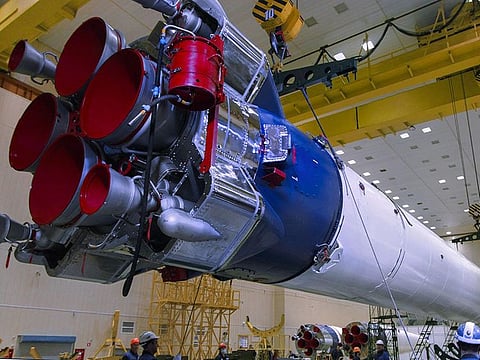How Dubai's DMSat-1 will help study sandstorms, fight global climate change
Dubai’s low-orbit environmental satellite to launch on Saturday from Baikonur Cosmodrome

Also In This Package
Dubai: DMSat-1, a nano satellite that will be launched on Saturday, is not only the region’s first low-orbit environmental satellite but is also the UAE’s contribution to combating global climate change.
Eng. Alia Al Harmoudi, director of Environment Department at Dubai Municipality, told Gulf News on Tuesday that DMSAT-1 has a role in implementing the provisions of the Paris Agreement, an agreement within the United Nations Framework Convention on Climate Change (UNFCCC) signed in 2016.
She noted DMSat-1 will provide information and data to monitor greenhouse gas emissions and build the UAE’s capacity to study global warming. Under the Paris Agreement, each country must determine, plan, and regularly report on the contribution that it undertakes to mitigate global warming.
According to Al Harmoudi, DMSat-1 is vital in studying the phenomenon of sandstorms in the UAE and the wider region. She noted dust is also considered as an air pollutant at it carries particles that may cause health problems, aside from causing irritation to nose, throat and eyes. DMSat-1 will be also be used to detect greenhouse gases and the data generated data will support environmental research and climate change related studies.
The satellite is scheduled to be launched on March 20 at 10.07am (UAE time) from Baikonur Cosmodrome in Kazakhstan aboard a Russian-made Soyuz 2.1a rocket that will lift off with CAS500-1 Earth observation satellite for the Korea Aerospace Research Institute (KARI), as well as smaller payloads for UK, Russia, Japan, Italy, Netherlands, Germany, Canada, Thailand, Spain, Slovakia, Argentina, Israel, Brazil, Hungary, Tunisia and Saudi Arabia.
Local and international collaboration
DMSat-1, built by engineers at Space Flight Laboratory (SFL) at the University of Toronto, is a collaboration between Mohammed Bin Rashid Space Centre (MBRSC) and Dubai Municipality. DMSat-1 will be the fourth satellite in orbit that will be operated by MBRSC, after DubaiSat 2, KhalifaSat and Hope Probe.
MBRSC will manage the gathering and delivery of data generated by the project for Dubai Municipality. The data will then be shared with academic institutions inside and outside the UAE as part of data-sharing with other countries, in compliance with the Paris Agreement, according to Al Harmoudi.
On the local level, DMSAT-1 will contribute in calculating the rate of carbon dioxide (CO2) emissions in relation to GDP as per Dubai 2021 Plan. It will also help in studying the environmental impact of Dubai Clean Energy Strategy 2050 and examine the effectiveness of the UAE Energy Strategy 2050. Moreover, it will contribute to the National System for Greenhouse Gas Emissions Management within the National Climate Change Plan 2017-2050.
Latest space technology
Engr. Adnan AlRais, DMSAT-1 Programme Director and Senior Director of Remote Sensing Department at MBRSC, said DMSat-1 will use the latest in space technology to perform monitor, collect and analyse environmental data as well as measure air pollutants and greenhouse gases in Dubai and the wider UAE.
DMSat-1, which weighs only 15kg and has a dimension of 20X30X40 cm with a solar panel spanning 50cm, is a high-performance nanosatellite designed to perform multispectral observations. It has three scientific instruments, including multispectral polarimeter used to monitor air quality and detect fine particles in the atmosphere and a pair of spectrometers that will be used to detect greenhouse gases (carbon dioxide and methane).
The multispectral polarimeter, in particular, is a relatively new technology used by few space missions. It is used for remote sensing to collect improved characterisation of atmospheric aerosol. DMSat-1’s polarimeter will monitor and measure air pollutant, develop an air quality map, study seasonal changes and levels of air pollutants, and study the sources of air pollutants.
The satellite, which operates in three bands — blue, red and infrared — was manufactured in 18 months at MBRSC. It is capable of covering an area of up to 80,000 square kilometres each day. DMSat-1 will monitor a single site more than once from seven different angles. Data will be stored on the on-board storage system and downloaded to MBRSC’s ground station. It will orbit Earth at an altitude of 550 kms 14 times a day and will pass over the MBRSC ground station four to five times daily to receive new imaging orders and enable downloading of data.
DMSat-1 journey
The satellite was first announced for launch in the second quarter of 2019. There was no interruption in manufacturing the satellite but the launch delay was on the part of the launch service provider, the pandemic and a couple of launch failures last year, according to DM and MBRSC. This year, a team of specialised engineers and project supervisors from DM and MBRSC have been based at the launch site at Baikonur Cosmodrome in Kazakhstan February 25.
The satellite was placed on the launch rocket on March 7 for initial preparations and tests were conducted up until March 12, the last day of inspection of instruments before the launch of DMSAT-1 aboard Soyuz 2.1a rocket at 10.07am (UAE time) on Saturday.
The satellite is expected to separate from the launch vehicle into its orbit at 2.20pm (UAE time) and send its first signal at 3pm (UAE time). The project team is comprised of employees and engineers from DM and MBRSC.
Soyuz rocket: At a glance
The Russian-made Soyuz-2a. 1 rocket that will carry DMSat-1 and 37 other satellites from 17 other countries has been given a white and blue livery to mark 60 years since the launch of cosmonaut Yuri Gagarin, who became the first human in space on April 12, 1961. The rocket will launch from 31/6 at Russia’s Baikonur Cosmodrome in Kazakhstan, near Site 1 where Gagarin lifted off aboard Vostok 60 years ago.
Sign up for the Daily Briefing
Get the latest news and updates straight to your inbox









